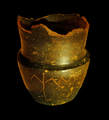TI·1: Difference between revisions
No edit summary |
No edit summary |
||
| Line 29: | Line 29: | ||
Images in '''{{bib|Stöckli 1975}}: 17 f., fig. 11''', {{bib|Solinas 1995}}: 327 (drawing), {{bib|Morandi 1999}}: 154, fig. 2 (drawing = {{bib|Morandi 2004}}: 525, fig. 8.2) and 188, pl. I.1&2 (photos). | Images in '''{{bib|Stöckli 1975}}: 17 f., fig. 11''', {{bib|Solinas 1995}}: 327 (drawing), {{bib|Morandi 1999}}: 154, fig. 2 (drawing = {{bib|Morandi 2004}}: 525, fig. 8.2) and 188, pl. I.1&2 (photos). | ||
Inscribed on the bottom of the beaker below the edge of the shoulder. The implausible reading ''mχme'' goes back to Whatmough. {{bib|Morandi 2004}} classifies the scratching as a pseudo-inscription, its zig-zag elements being comparable to the non-script section of [[NO·1]] (see also {{bib|Morandi 1999}}: 154). That the inscription is at least script-adjacent is also indicated by the only plausible letter shape, epsilon {{c||E8|d}} with four bars, which is attested in the coin legend [[NM·6]], and otherwise more commonly in the Camunic alphabets, e.g. on the [[GR·3|Castaneda flagon]] from the same area and timeframe as the Gudo beaker. | Inscribed on the bottom of the beaker below the edge of the shoulder. The implausible reading ''mχme'' goes back to Whatmough. {{bib|Solinas 1995}} refers to "segni forse alfabetici", {{bib|Morandi 2004}} classifies the scratching as a pseudo-inscription, its zig-zag elements being comparable to the non-script section of [[NO·1]] (see also {{bib|Morandi 1999}}: 154). That the inscription is at least script-adjacent is also indicated by the only plausible letter shape, epsilon {{c||E8|d}} with four bars, which is attested in the coin legend [[NM·6]], and otherwise more commonly in the Camunic alphabets, e.g. on the [[GR·3|Castaneda flagon]] from the same area and timeframe as the Gudo beaker. | ||
<p style="text-align:right;>[[User:Corinna Salomon|Corinna Salomon]]</p> | <p style="text-align:right;>[[User:Corinna Salomon|Corinna Salomon]]</p> | ||
{{bibliography}} | {{bibliography}} | ||
Revision as of 12:23, 6 October 2023
| Inscription | |
|---|---|
| Reading in transliteration: | ???? |
| Reading in original script: | |
|
| |
| Object: | TI·1 Gudo (beaker) |
| Position: | bottom, outside |
| Orientation: | 0° |
| Direction of writing: | dextroverse |
| Script: | unknown |
| Number of letters: | 0 |
| Number of words: | 1 |
| Number of lines: | 1 |
| Workmanship: | scratched after firing |
| Condition: | complete |
|
| |
| Archaeological culture: | Golasecca II B [from object] |
| Date of inscription: | late 6th c. BC [from object] |
|
| |
| Type: | unknown |
| Language: | none |
| Meaning: | unknown |
|
| |
| Alternative sigla: | Whatmough 1933 (PID): note XV Solinas 1995: 17 Motta 2000: 16 Morandi 2004: 2 |
|
| |
| Sources: | Morandi 2004: 520 no. 2 |
Images
|
| ||||
Commentary
First mentioned in PID: n. XV.
Images in Stöckli 1975: 17 f., fig. 11, Solinas 1995: 327 (drawing), Morandi 1999: 154, fig. 2 (drawing = Morandi 2004: 525, fig. 8.2) and 188, pl. I.1&2 (photos).
Inscribed on the bottom of the beaker below the edge of the shoulder. The implausible reading mχme goes back to Whatmough. Solinas 1995 refers to "segni forse alfabetici", Morandi 2004 classifies the scratching as a pseudo-inscription, its zig-zag elements being comparable to the non-script section of NO·1 (see also Morandi 1999: 154). That the inscription is at least script-adjacent is also indicated by the only plausible letter shape, epsilon ![]() with four bars, which is attested in the coin legend NM·6, and otherwise more commonly in the Camunic alphabets, e.g. on the Castaneda flagon from the same area and timeframe as the Gudo beaker.
with four bars, which is attested in the coin legend NM·6, and otherwise more commonly in the Camunic alphabets, e.g. on the Castaneda flagon from the same area and timeframe as the Gudo beaker.
Bibliography
| Baserga 1911 | Giovanni Baserga, "La necropoli preromana di Gudo nel Canton Ticino", Rivista Archeologica di Como 62 (1911), 95. |
|---|





